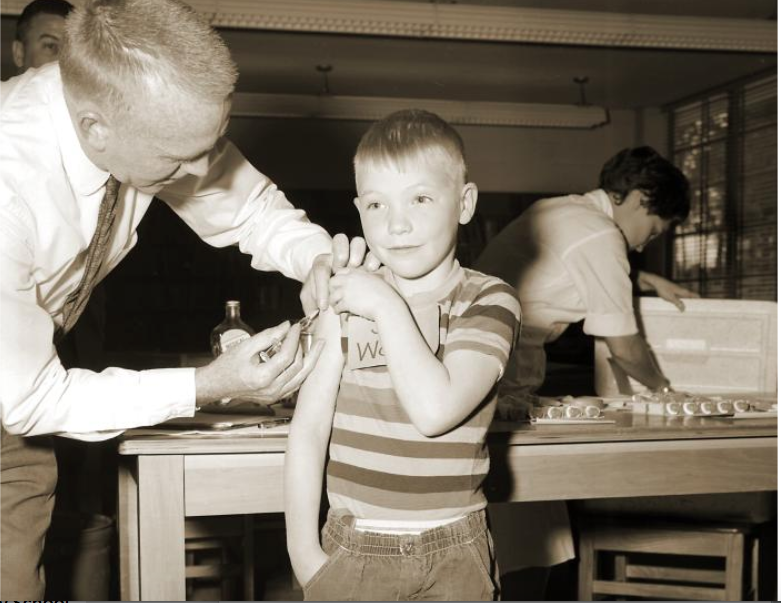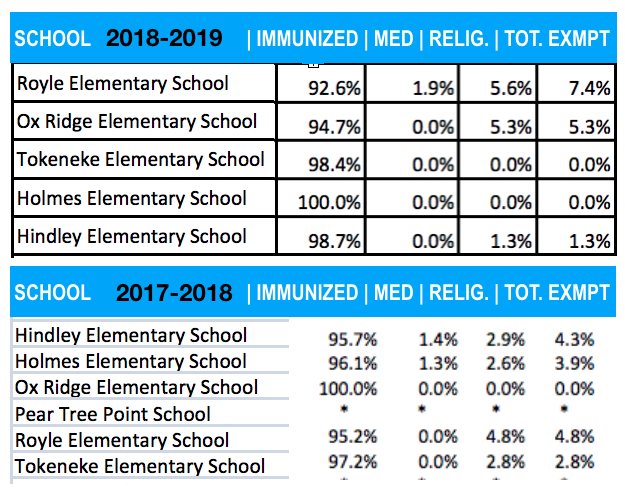Parents citing “religious” reasons for exempting their children from common immunizations are driving down the rates of child vaccinations across Connecticut, according to information released from the Connecticut Department of Public Health.
Medical exemptions, which come from physicians using their medical knowledge to recommend that certain children not be immunized, are less common. Medical reasons for rejecting immunization only accounted for 1.9 percent of last year’s kindergarten population at Royle School, for instance, and no other school in town had any.
On Monday, the state Department of Public Health released school-by-school figures for kindergartner immunizations across the state. The DPH released figures for both the last school year (2018-2019) and the year before (2017-2018).
Darien Immunization Rates in Different School Years
- Do school immunization rates commonly bump up and down, sometimes over and sometimes under 95%? The state has only released school-by-school figures for only the past two school years. They show increases in the numbers of children not getting vaccinated.
- Darien schools showed significant differences between the two school years.
Measles vaccination rates vary from year to year. No Darien schools were below 95 percent in the 2017-2018 school year, although Royle, which had the worst rate in both school years, came close. KEY: Percent vaccinated, percent of medical exemptions, percent of religious exemptions, percent of total exemptions.
State health officials have said that with only 5% of a student group not immunized, the risk of measles or other communicable diseases spreading can cause medical experts to become concerned.
In assessing the risk, officials make no distinction on whether the student group is large or small, but for a school to go above or below the 5 percent figure takes less than a handful of students in Darien’s five elementary schools. Here’s what kindergarten enrollment looked like as of Oct. 1, 2018, the same year as the latest immunization rates reported by the state Department of Public Health:

Image from Darien Public Schools
Kindergarten (and Early Learning Program) enrollment, school by school, in Darien as of Oct. 1, 2018.
With only 53 kindergartners at Royle School, for instance, the 1.9 percent of students there with an exemption from immunization for medical reasons in that school year represents a single student. The 7.4% of total exemptions from immunization is four students in that school. A single family with triplets, if all were not immunized, could drive a school from 100% immunizations to less than 95% in a single year.
Ox Ridge had 57 students in its kindergarten classes on Oct. 1, 2018. The 5.3% rate of non-immunized students amounts to three pupils.
2017-2018 School Year Kindergarten Enrollment

Darien Public Schools website
Enrollment in kindergarten classes (and Early Learning Program classes) as of Oct. 1, 2017
Where Immunization Rates Are Lowest
Private schools, some religious schools and Montessori schools around the state tended to have particularly low rates of immunization, the Hartford Courant reported.
See also: Kindergarten Immunizations Low at Royle, Ox Ridge Schools, Wide Variations Across Town (Monday, Oct. 21)
Low immunization rates appear to be “linked to (higher) education and income” of parents, Darien Health Director David Knauf said. Perhaps people with those attributes are more used to questioning and making decisions that may be outside the recommended process,” he said.
Knauf said he hopes parents who avoid immunizing their children reconsider: “You have this kind of responsibility to be a good partner with others in the community and protect the population,” he said. We’re working together, and if we fall below those critical numbers, who knows what the outcome could be.”
— video courtesy of the Mayo Clinic News Network
Some Measles FAQs
How Dangerous Is It?
“While most recover from the infection, measles can lead to serious complications. About 1 in 4 individuals who contract measles will be hospitalized. One in 10 children with measles will develop ear infections, which can lead to permanent hearing loss. One in 1,000 will develop swelling of the brain (encephalitis), which can result in permanent brain damage. A similar proportion will die from the infection.” — National Public Radio, April 30, 2019

Photo from the Centers for Disease Control
A schoolboy receiving a measles vaccination in 1962 in Atlanta.
“Measles can be serious. Children younger than 5 years of age and adults older than 20 years of age are more likely to suffer from complications. Common complications are ear infections and diarrhea. Serious complications include pneumonia and encephalitis.” — from the Centers for Disease Control website
“Before the measles vaccination program started in 1963, an estimated 3 to 4 million people got measles each year in the United States, of which 500,000 were reported. Among reported cases, 400 to 500 died, 48,000 were hospitalized, and 1,000 developed encephalitis (brain swelling) from measles.” — from the Centers for Disease Control website
How Easy Is It to Get Measles?
From the Mayo Clinic website: “[ Dr. [Gregory] Poland, [director of the Mayo Clinic Vaccine Research Group], says the measles virus is transmitted by air. ‘It’s more deadly than influenza, and measles is the most contagious disease we know of. If you and I were both susceptible to measles and somebody came into this room eight hours ago with measles, we would both get infected. It’s that contagious.'”
National Public Radio reported that “If an infected person coughed in a room, 90% of non-vaccinated people in that room would become infected. The virus can linger in the air for up to two hours, according to the Centers for Disease Contol and Prevention.”
Should Parents of Vaccinated Children Be Concerned About Measles?
From the same Mayo Clinic website article: “Two doses of MMR vaccine are approximately 97% effective at preventing measles.” The Centers for Disease Control says the same thing. So for every 101 students in the same room together, it would not be statistically unusual for one child with measles to give it to three others, even if every student were immunized.
The CDC also says “fully vaccinated people who get measles are much more likely to have a milder illness. And fully vaccinated people are also less likely to spread the disease to other people […]”
SEE ALSO
- 4 things everyone needs to know about measles (Harvard Health Publishing and the Harvard Medical School; Feb. 5, 2019)
- Measles outbreak in southwestern Washington rises to 50 cases, by Dr. Shamard Charles (NBC news website, Feb. 4, 2019). This article contains a lot of clearly written background information on measles
- How Did We Get Here? 7 Things To Know About Measles (National Public Radio, April 30, 2019)


